Top 10 Meditation Retreats in Tibet
- by Catherine
- Last Updated: 2024-05-20
Meditation can allow us to fully release stress, find inner peace and explore the potential of the mind. While traveling to Tibet can allow us to see different plateau scenery and find freedom and relaxation during the journey. If you combine meditation and Tibet travel, it will be an amazing journey of a lifetime!
Here are the best five meditation destinations in Tibet including the top ten meditation retreats. Where do you prefer to go?
No.1: In and Around Lhasa:
Lhasa, the holy land of Tibetan Buddhism, also called Sunlight City, is located in the middle of the Tibetan Plateau. It is the capital of the Tibet Autonomous Region and the political, economic, cultural, and religious center, at an altitude of 3658 meters above sea level.
This is a gathering place for devout believers. All the time, countless believers prostrate thousands of times, along their pilgrimage roads to Lhasa.
What you should experience most in Lhasa is a slow lifestyle. Here, you will unconsciously slow down your pace and rhythm, follow the local Tibetans on the kora road of Barkhor Street at will and make some good wishes and blessings.
There are some great places for meditation in and around Lhasa,
Drak Yerpa Retreat
Drak Yerpa Monastery is one of the four major meditation retreats in Tibet. It was built in the 7th century and has a history of 1,500 years. Located about 20 kilometers northeast of Lhasa, it belongs to Dazi County.
Unlike the surrounding mountains with only a shallow layer of turf on the surface, the mountain where Drak Yerpa sits is full of a natural aura. The pines and cypresses on the mountain are tall and straight, dense and green, the spring water on the mountainside trickle down, and streams are gurgling at the foothill. In spring and summer, the mountain flowers are blooming, and all the birds are singing.
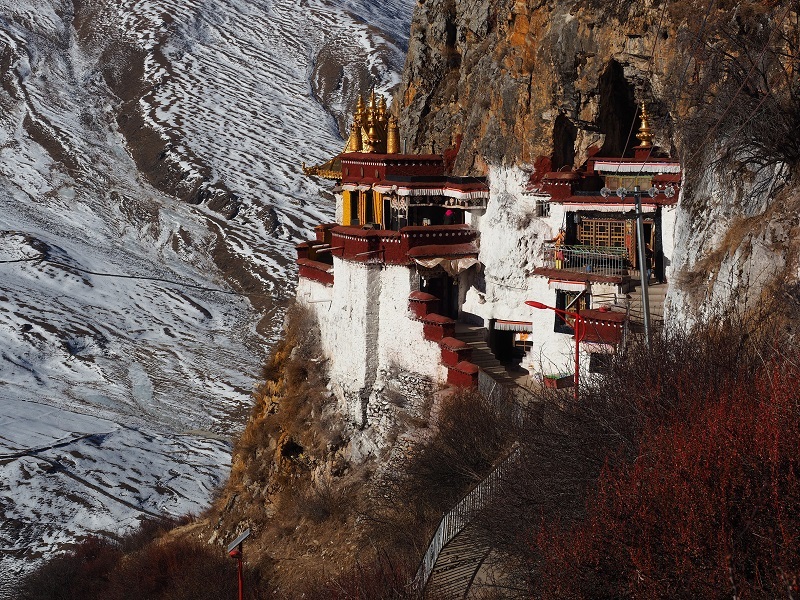
There are many caves for practice in the mountains, and the temple was built on the basis of these caves. The caves include Dharma Cave where the King Songtsen Gampo practiced, the Moon Cave where the Padmasambhava practiced, the Lhalung Cave where the Lhalung Palkyi Dorje who assassinated the last Tubo Emperor practiced, the Patriarch Cave where the Atisha practiced, etc. This is a highly recommended place for meditation tours.
√ 5 Days Lhasa & Ganden Monastery Tour
Pabonka Hermitage
Pabonka is located in the northern suburbs of Lhasa, about 7 kilometers from the center of Lhasa, with Sera Monastery on the left.
Pabongka is a temple built on the rock, where Princess Wencheng and Songtsen Gambo practiced before they got married. And there is also a cave where Master Padmasambhava practiced. Pabongka enshrines a stele with the first Tibetan six-syllabled Sanskrit mantra, and it is the birthplace of the six-syllabled Sanskrit mantra.
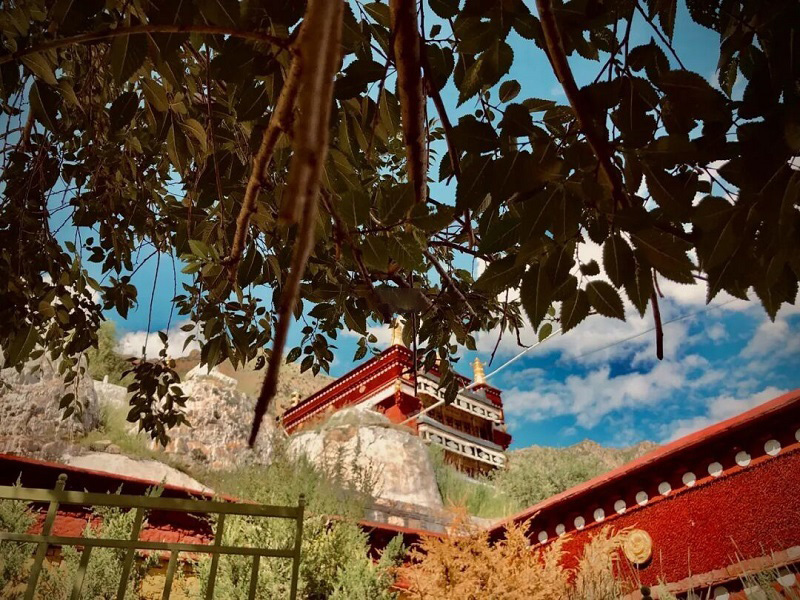
There are very few tourists, mainly locals. On the back mountain, there are many prayer flags fluttering and cattle and sheep grazing. From here, you can overlook the scenery of the entire Lhasa River Valley as well as the back view of the Potala Palace. It is absolutely suitable for meditation in Tibet.
√ 5 Days Sera Utsé Hermitage Half Day Tour
Namtso Lake
Namtso, located in the central part of the Tibet Autonomous Region is the second largest lake in Tibet. Namtso, Manasarovar, and Yamdrok Lake are collectively known as the three holy lakes in Tibet.
For thousands of years, they have been deeply imprinted in people's minds with their unique natural charm and many mythical legends. Namtso is like a crystal gem, inlaid on the prairie. With its magnificent scenery and beautiful legends, it has intoxicated many tourists and pilgrims.
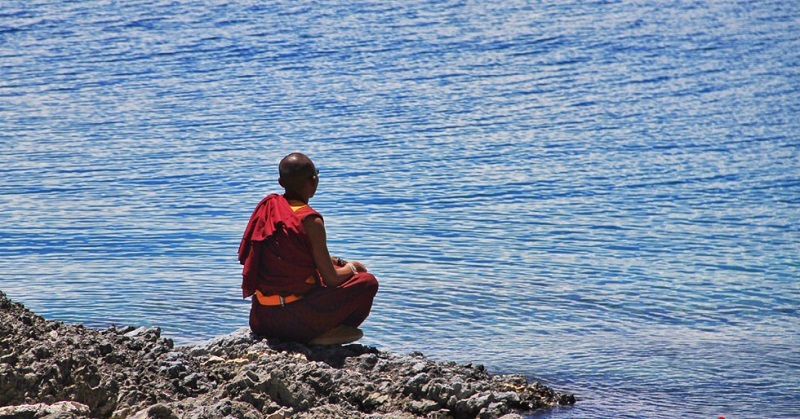
Everyone who has been to Namtso, whose entire soul might be cleaned by pure lake water, as if exposed to the blue ocean. Coming here to have Tibetan meditation tours, you can eliminate all interference from the outside world, and devote yourself to such a pure blue world. It is simply wonderful!
√ 5 Days Lhasa & Namtso Lake Tour
No.2: Shannan (Tsetang) – Birthplace of Tibetan
Shannan is the birthplace of Tibetan culture, where the legend is that the god monkey and the Rakshasi combined to give birth to Tibetans. The Shannan area is located in the middle valley of the Yarlung Zangbo River. There're magnificent mountains and rivers, mysterious sacred lakes, picturesque virgin forests, vast grasslands, majestic and steep Yarlung Zangbo waterfalls, as well as time-honored cultural relics and ancient books. There is no severe cold in winter and no scorching heat in summer. The weather is pleasant in all seasons and is very suitable for meditation.
Samye Monastery
Samye Monastery is located at the foot of Mount Harbu on the north bank of the Yarlung Zangbo River. It was built in the 8th century AD during the Tubo dynasty and was the first monastery in Tibet where laymen were ordained as a monk.
The whole monastery was built like a mandala in the Buddhist Tantra. The Utse Hall is like Mount Sumeru, the center of the universe. The four temples around the main hall seem to symbolize the four continents, the four pagodas symbolize the four heavenly kings guarding the four continents, and there are a total of 1,028 small pagodas on the surrounding wall of Samye Monastery. This is also very special, symbolizing the Cakravāda-parvata around the world.
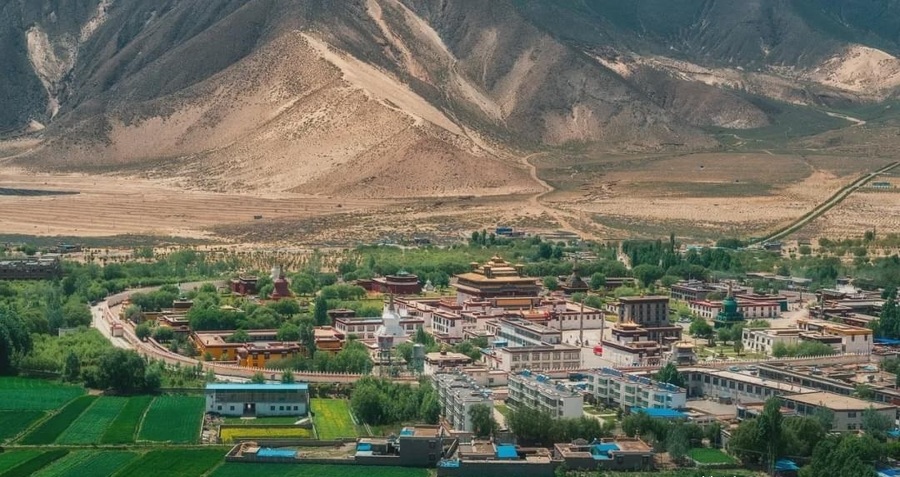
If you overlooked the whole view of Samye Temple from nearby mountains, you can see its beautiful structural layout, just like a three-dimensional mandala. This beautiful mandala standing in the real world allows people to understand the strict order of the Tibetan Buddhist worldview.
√ 5 Days Lhasa & Samye Monastery Tour
Chim-puk Valley
Chim-puk Valley is located on the side of Hapori Mountain, 15 miles northeast of Samye Monastery, with an average elevation of 4,300 meters. It is surrounded by mountains on three sides. The open area on the south side of the valley is directly opposite the broad Yarlung Zangbo Valley and the view is very impressive.
Because Chim-puk Valley is deep in the mountains and the streams are gurgling with dense vegetation, there's no severe cold in winter and no scorching heat in summer but mild climate throughout the year. This is probably the reason why many eminent monks and laymen have regarded this place as a sacred place for self-cultivation and enlightenment throughout the ages. The eminent monks such as Śāntarakṣita and Padmasambhava practiced here successively, leaving many sacred sites.
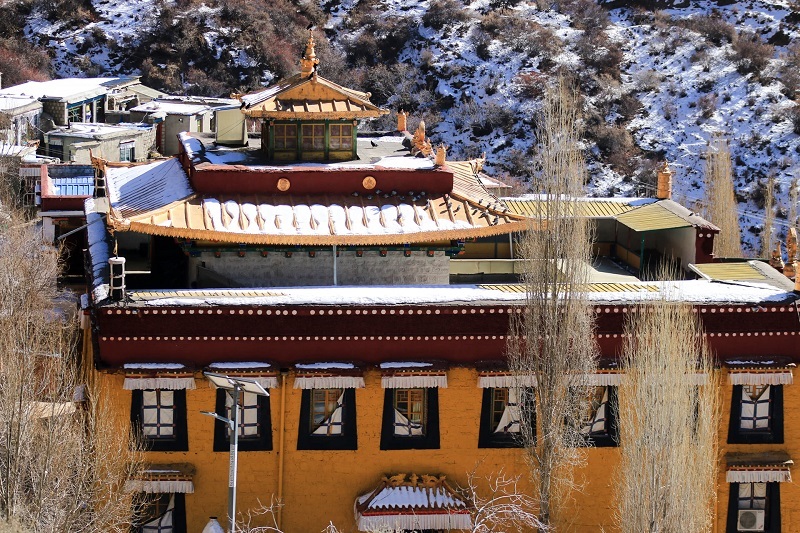
Tibetans believe Chim-puk is an important place. They think that only visiting Samye Monastery without going to Chim-puk is as if they have never been to Samye Monastery.
No.3: Shigatse, the Seat of the Panchen Lama
Shigatse, the second-largest city in Tibet, is about 300 kilometers away from Lhasa. It is the seat of the successive Panchen Lamas. The famous Tashilhunpo Monastery, Sakya Monastery, Pelkor Chode Monastery, Shalu Monastery, and many other temples constitute the dense religious culture of many sects.
There's beautiful natural scenery and rich cultural landscapes, such as the snow-capped mountains and ice peaks represented by Mount Everest, the beautiful virgin forest, the sacred mountains, holy lakes, and grasslands that complement each other, as well as the mysterious temples, and the unique cultural customs of Ü-Tsang, which make Shigatse a suitable destination for tourists who wish to go to Tibet for meditation.
Tashilhunpo Monastery
Tashilhunpo Monastery is located in the urban area of Shigatse. It's the resident place for successive Panchen Lamas since the fourth generation. The entire temple is built on the hillside, backed by mountains, and located in the North, facing the sun from the north. There are many temples in the complex, and they are connected one after another, with equal distances apart, appearing harmonious and symmetrical.
The worshippers can be seen everywhere, but they are very quiet. Their devotion to the Buddha is that no matter where they are, they will come to temples, sacred mountains, and holy lakes to fulfill their aspirations in this life.
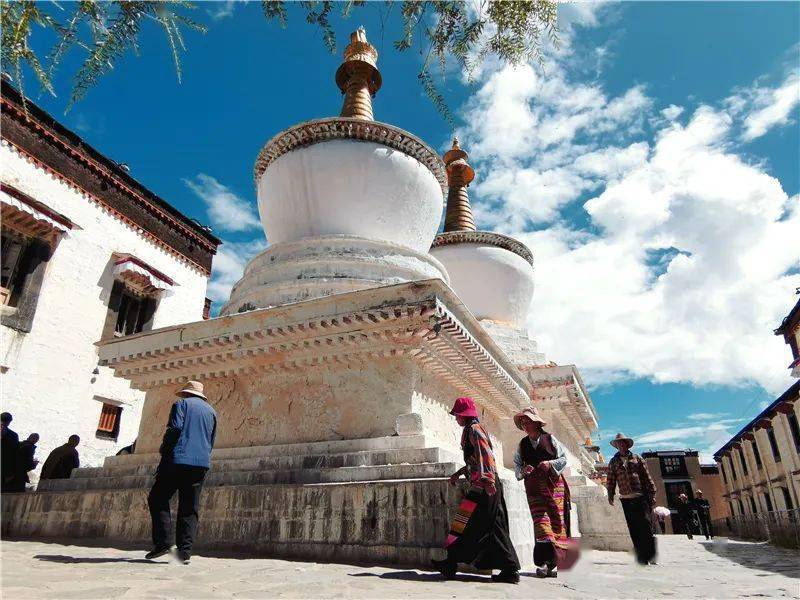
There is also a meditation place on the back mountain of Tashilhunpo Monastery where you can free up your mind. Stopping here for a while will make your body and soul sublimate.
√ 6 Days Lhasa Gyantse Shigatse Group Tour
Sakya Monastery
The Sakya Monastery is located at the foot of Benbo mountain, only 45 kilometers away from Shigatse City. It's the main monastery of the Sakya Sect of Tibetan Buddhism.
At the entrance of the temple, you will be attracted by the color of the outer wall of the monastery. The red symbolizing Manjushri, the white symbolizing Guanyin Bodhisattva, and the blue symbolizing the Vajra Bodhisattva. The three colors decorate the walls in harmony and unity.
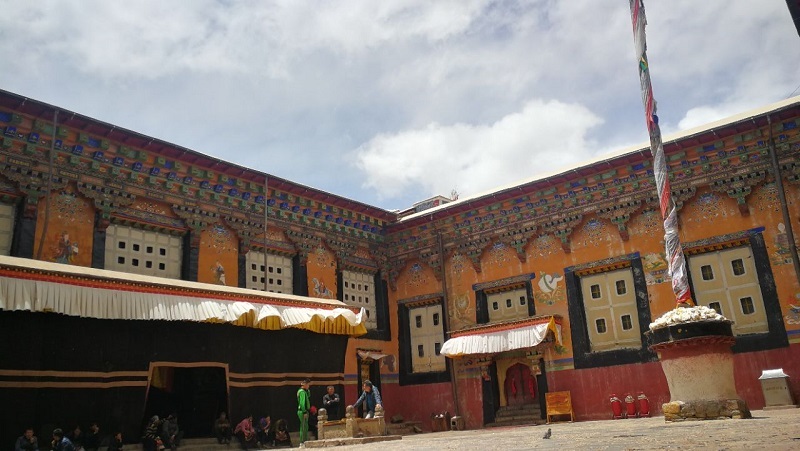
The most stunning feature of Sakya Monastery is its huge wall of scriptures. This wall is all made up of piles of scriptures one by one, about 9 meters high and more than 60 meters wide. Renowned as the monastery with most scriptures in Tibet and even the world, there're more than 84,000 scriptures. For a thousand years, generations of monks were writing Buddhist scriptures with gold, silver, and cinnabar powder or ink, using Sanskrit or Tibetan to translate, copy, and worship religiously.
Besides its scriptures, Sakya Monastery is also famous for Buddha statues and mural paintings. Here, you can clean yourself and let your impetuous soul slowly calm down. It is a good place to relieve stress and meditation.
√ 7 Days Lhasa Shigatse Everest Base Camp Sakya Tour
No.4: the Everest Region
Mount Everest in the Himalayas is the highest mountain in the world, with soaring heights, steep and uneven peaks, amazing valleys and alpine glaciers, in which you cannot help sighing that the world is big and we are so tiny beings, like dust.
This is a holy place for extreme sports enthusiasts, and it also attracts many meditation practices to come to the vicinity of Mount Everest, to experience the realm of being one with nature.
Rongbuk Monastery
Rongbuk Monastery is just next to the Everest Base Camp. The monstery is not very big, but it is the highest monastery in the world, at an altitude of 5145 meters above sea level.
The Rongbuk Monastery was set into a hillside. Around the monastery, there's a white pagoda, tall Mani stones, golden prayer wheels, and fluttering prayer flags, making the monastery spectacular, especially with the backdrop of Mount Everest not far away. The murals on the wall in Rongbuk Monastery are bright in color, soft in line, and clear and vivid for the characters. The sacred and solemn hall cannot help but let people hold their breath, and pray in piety.

Three kilometers north of Rongbuk Monastery, there's a cave where Guru Padmasambhava ever practiced. Till today, you can still see the stones with the handprints and footprints of Padmasambhava as well as some stone pagodas.
√ 8 Days Lhasa to Everest Base Camp Group Tour
No.5: Ngari Area in West Tibet
The Ngari area is located in the core area of the Qiangtang Plateau, in the northern part of the Tibetan Plateau. It is one of the least densely populated areas in the world and has a unique plateau natural style. Ngari is also the place where the Himalayas, Gangdisi Mountains, and Kunlun Mountains converge, so it's called "the ancestor of ten thousand mountains."
Meanwhile, Ngari is a mysterious tour destination. There are not only holy mountains, sacred lakes, the most shocking yellow sand, and the blue sky, but also endless long roads ahead of you. It is a spiritual journey to sharpen the wits.
Mount Kailash and Lake Manasarovar
Mount Kailash and Lake Manasarovar can be the most profound holy places among all pilgrimage destinations, and they are regarded by many pilgrims as the peak experience in a lifetime.
The five major religions---Hinduism, Jainism, Buddhism, Sikhism, and Bon religion all recognize the sacred Mount Kailash and Lake Manasarovar as the center of the world, and countless myths and legends were passed down from here.
The first yogi Shiva, Buddha, and Jain Theerthankars(founder of Jainism) established a certain connection with Mount Kailash and Lake Manasarovar, which increased the sacredness and mystery of this place.
The lake surface of Manasarovar Lake is 4,588 meters above sea level and 20 kilometers away from Mount Kailash, known as the most beautiful and sacred lake in the world.
It is said that the holy lake nurtures the wish tree Kalpavriksha and Kalpavriksha is considered the source of all creation. The blue and emerald green water of the holy lake has a magical healing effect.
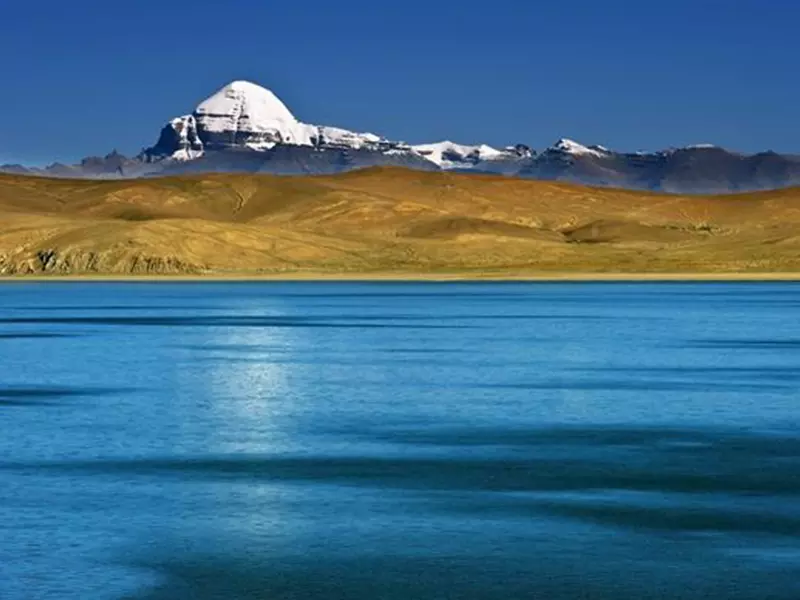
This area is very suitable for meditation tours. Hiking here is not just a journey, and it is the ultimate expression of pilgrims' pursuit of enlightenment. Doing a kora around Mount Kailash or Manasarovar, you can achieve deep spiritual transformation, absorb the power and energy contained in this holy land, and step into higher dimensions of life, especially when you follow an enlightened master, every step you take will be firmer, stronger, and clearer.
√ 15 Days Mt.Everest & Mt.Kailash Kora Pilgrimage Group Tour
Pangong Tso
Pangong Tso is located on the border of the Ngari region. In Tibetan, it means "bright and narrow lake". One part of the lake is in Ngari, and the other part is in India. The most peculiar thing about Pangong Lake is that it is fresh water on the Chinese side but saltwater on the Indian side. The morning sun shines on the mountains by the lake, showing golden yellow and gleaming, but the surface of the lake is quite blue.
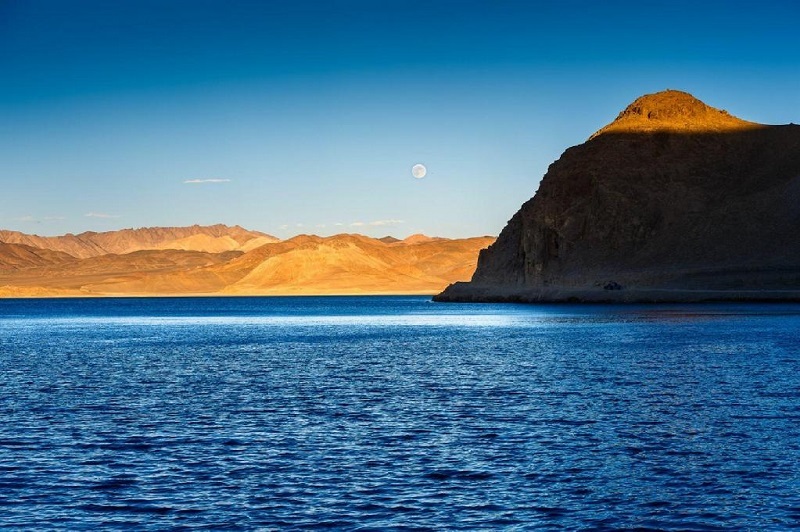
The surrounding scenery of Pangong Tso Lake is beautiful. The lake is embraced by mountains, with snow on the mountain tops in distance. The water is clear and has a visibility of 3 to 5 meters. Due to factors such as light, depth, and brightness, it presents different colors such as dark green, light green, and dark blue, which are very beautiful. At night, the sky above is starry, and the wide lake reflects the sky, quiet and deep. So the night scene also has a different charm. A dozen islands of various sizes sit in the lake, with about 20 species of birds on the islands. Here is a paradise for birds and animals.
Meditating in such a peaceful and serene place, all your worries will become a let-down emptiness in the sky.
Related Articles
- How to Visit Tibet?
- Xining to Lhasa Train
- Shanghai and Tibet Tours
- Mount Kailash Tour
- Tibet Landscape
- Kathmandu to Lhasa
- Yunnan and Tibet Tours
- Tibet Altitude - Elevation List of Different Places in Tibet
- Tibetan Buddhism Facts
- Travel to Tibet from United States
Email response within 0.5~24 hours.


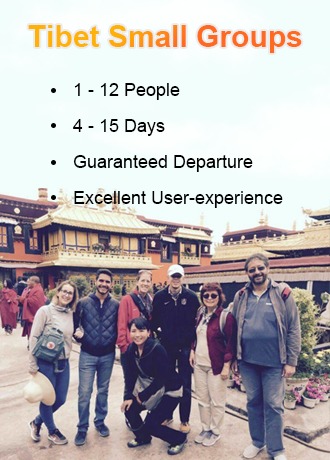

Typically Asked Questions from Our Clients
Asked by Sona***
Hi, I’d like to go to Tibet for a meditation retreat and sightseeing, would you have any schedule in January 25 please?
Dear Sona****,
We don't have a specialized meditation retreat tour but we can arrange a visit to the monastery where you can have a meditation retreat in the daytime. I recommend 5 Days Lhasa & Ganden Monastery Group Tour to you. We can open one around January 3rd but it needs further confirmation. Or we can arrange a private tour.
Asked by Anna***
Hello.
Where should I start? I think I am going through some existential criris, and I would need some spiritual guidance to re-explore my soul, my need and my priorities.
Is this kind of experience with monks also for gilrs?
Thanks a lot
Dear Anna****,
If you are traveling to Tibet to find your needs and priorities, we could help you. But I'm afraid tourists can't experience the monk's daily life. You can talk with them via a Tibetan tour guide but you can't stay with them alone, or stay overnight at monasteries, which is prohibited by the authority.
Asked by Jami***
Hello, I was searching for answers and peace within my soul. I think I am going through some sort of spiritual awakening, but I have a very cynical mind and tend to question everything. I though spiritual retreat where I could stay in the monastery, experience, learn and being guided by the monks in order to understand and trust in the spirituality concept might be very healing and enable my journey of soul searching. Reading through the options I am attracted to option 1, in and out of Lhasa, however I am open minded for the suggestions. Could you please let me know what do you think and costs?
Dear Jami****,
We can arrange a meditation tour for you. However, guests are not allowed to stay overnight in the monastery and we are not able to arrange the monks to guide you. You can stay in the monastery or the cave during the daytime to do meditation. What's your idea?
I recommend 5 days Lhasa & Ganden Monastery Tour for you. Here is the itinerary. If you agree, I'll quote you in my next email. Let me know your preferred hotel class. Thanks.
Asked by Kary***
Hi, I am looking for a meditation immersion tour in Tibet, preferably in a Monastery. I would like to know if any of your tours offer it, or if you know any company that does.
Dear Karym****,
We can arrange a meditation immersion tour in Tibet for you in May 2024. For the monastery to meditate, I suggest Drak Yerpa Monastery.
Drak Yerpa Monastery is one of the four major meditation retreats in Tibet. It was built in the 7th century and has a history of 1,500 years. Located about 20 kilometers northeast of Lhasa, it belongs to Dazi County. There are many caves for practice in the mountains, and the temple was built on the basis of these caves. The caves include Dharma Cave where the King Songtsen Gampo practiced, the Moon Cave where the Padmasambhava practiced, the Lhalung Cave where the Lhalung Palkyi Dorje who assassinated the last Tubo Emperor practiced, the Patriarch Cave where the Atisha practiced, etc. This is a highly recommended place for meditation tours.
Asked by Kris***
Hi, I'd like to attend a meditation retreat in Tibet or a combination of sightseeing and several days of meditation (full on day would be the best). Time to visit would be from September 29th to Sep. 7th.
Dear Kris****,
Thank you for sending us an inquiry!
As per your request, we can arrange a Tibet tour with a meditation retreat for you. However, is your tour date from 7 September to 29 September or from 29 September to 7 October? I can recommend the tour accordingly!
Read More ...